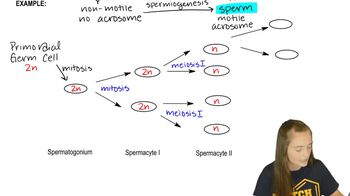9. Mitosis and Meiosis
Development of Animal Gametes
9. Mitosis and Meiosis
Development of Animal Gametes
Practice this topic
- Multiple Choice
Horse diploid cells contain 64 chromosomes (2n = 64). How many chromosomes will be present in spermatogonium cells?
- Multiple Choice
Horse diploid cells contain 64 chromosomes (2n=64). How many chromosomes will be present in primary oocyte cells?
- Multiple Choice
Horse diploid cells contain 64 chromosomes (2n=64). How many chromosomes will be present in spermatids cells?
- Multiple Choice
What is the correct term for the mature female gamete?
- Open QuestionContrast spermatogenesis and oogenesis. What is the significance of the formation of polar bodies?
- Open QuestionDuring oogenesis in an animal species with a haploid number of 6, one dyad undergoes nondisjunction during meiosis II. Following the second meiotic division, this dyad ends up intact in the ovum. How many chromosomes are present in (a) the mature ovum and (b) the second polar body? (c) Following fertilization by a normal sperm, what chromosome condition is created?
- Open Question
Which of the following does not describe a homologous chromosome?
- Open QuestionWolves and coyotes can interbreed in captivity; and now, because of changes in their habitat distribution, they may have the opportunity to interbreed in the wild. To examine this possibility, mitochondrial DNA from wolf and coyote populations throughout North America—including habitats where the two species both reside—was analyzed, and a phylogenetic tree was constructed from the resulting data (see Section 1.4 for details on how this is accomplished). Sequence from a jackal was used as an outgroup and a sequence from a domestic dog was included, demonstrating wolves as the origin of domestic dogs. What do you conclude about the possibility that interspecific hybridization occurred between wolves and coyotes on the basis of this phylogenetic tree?

